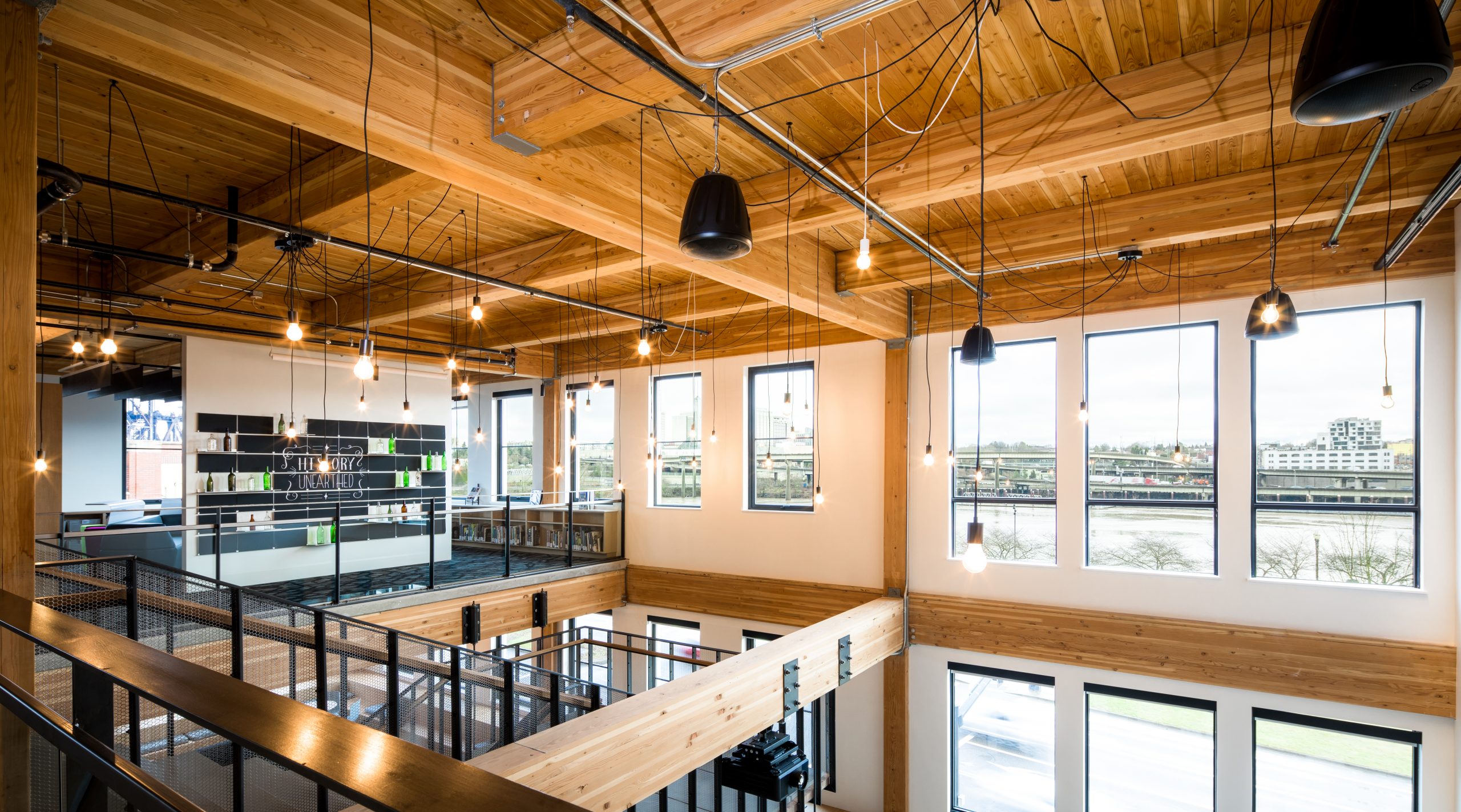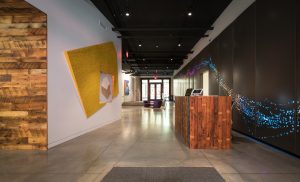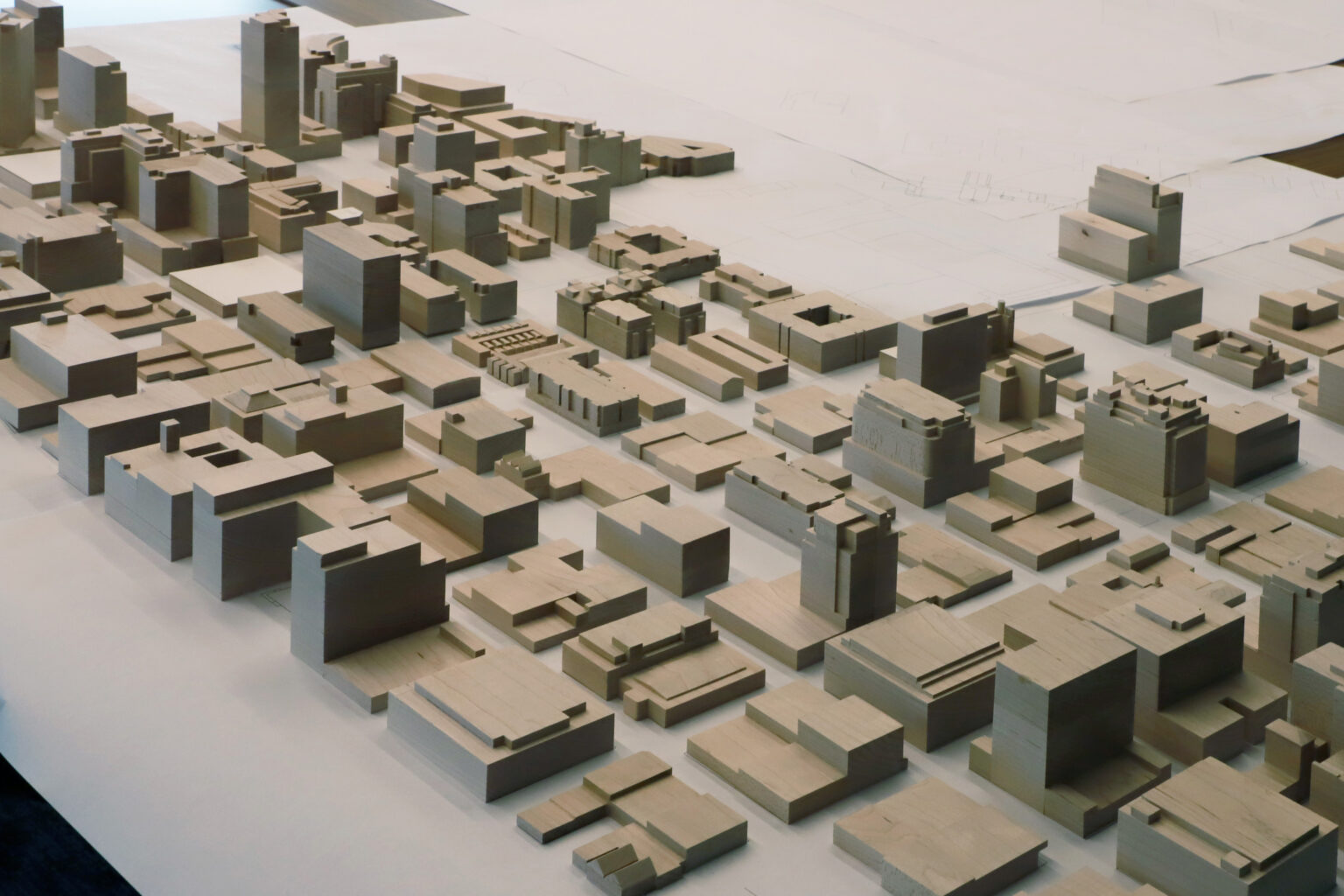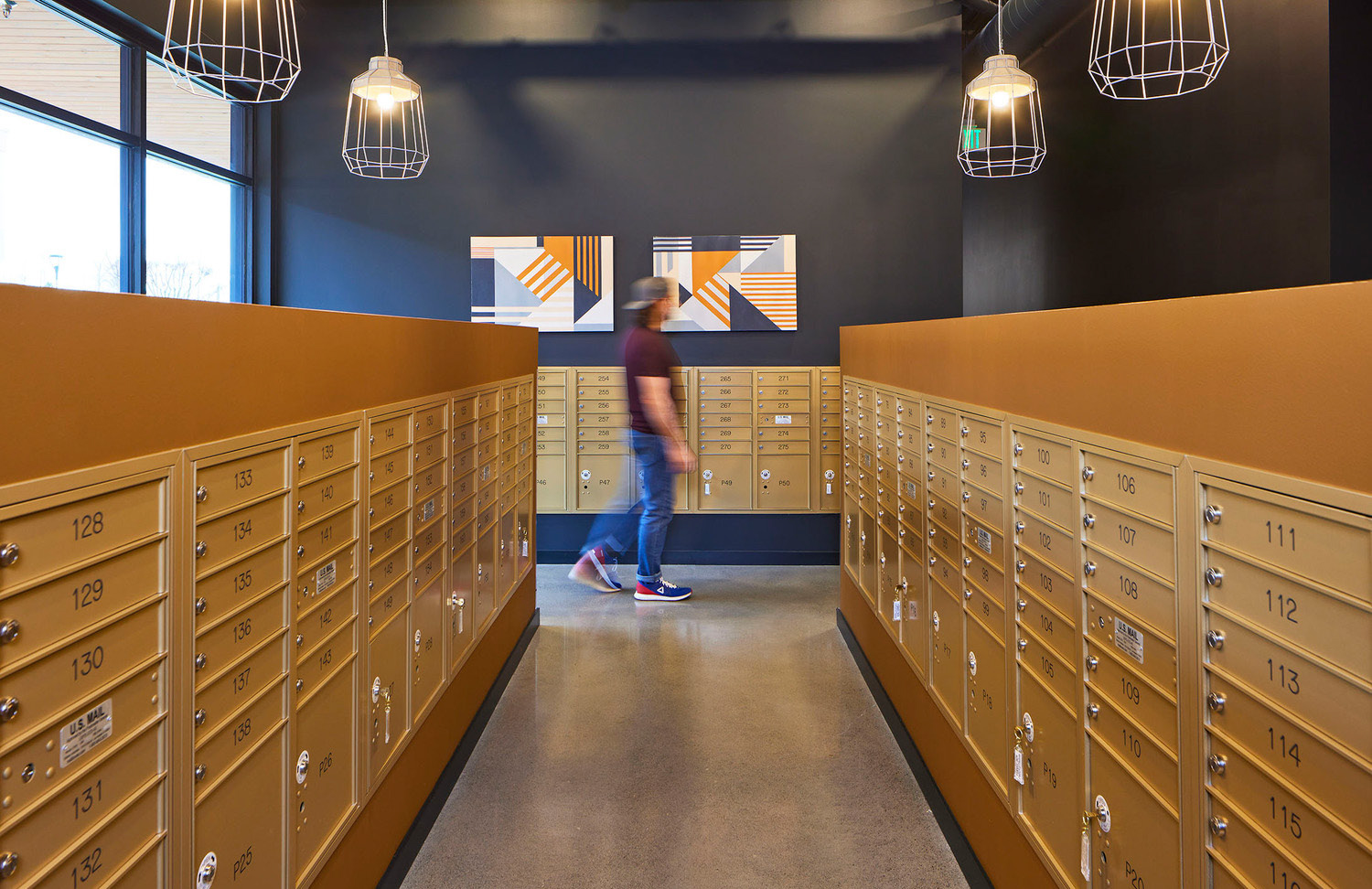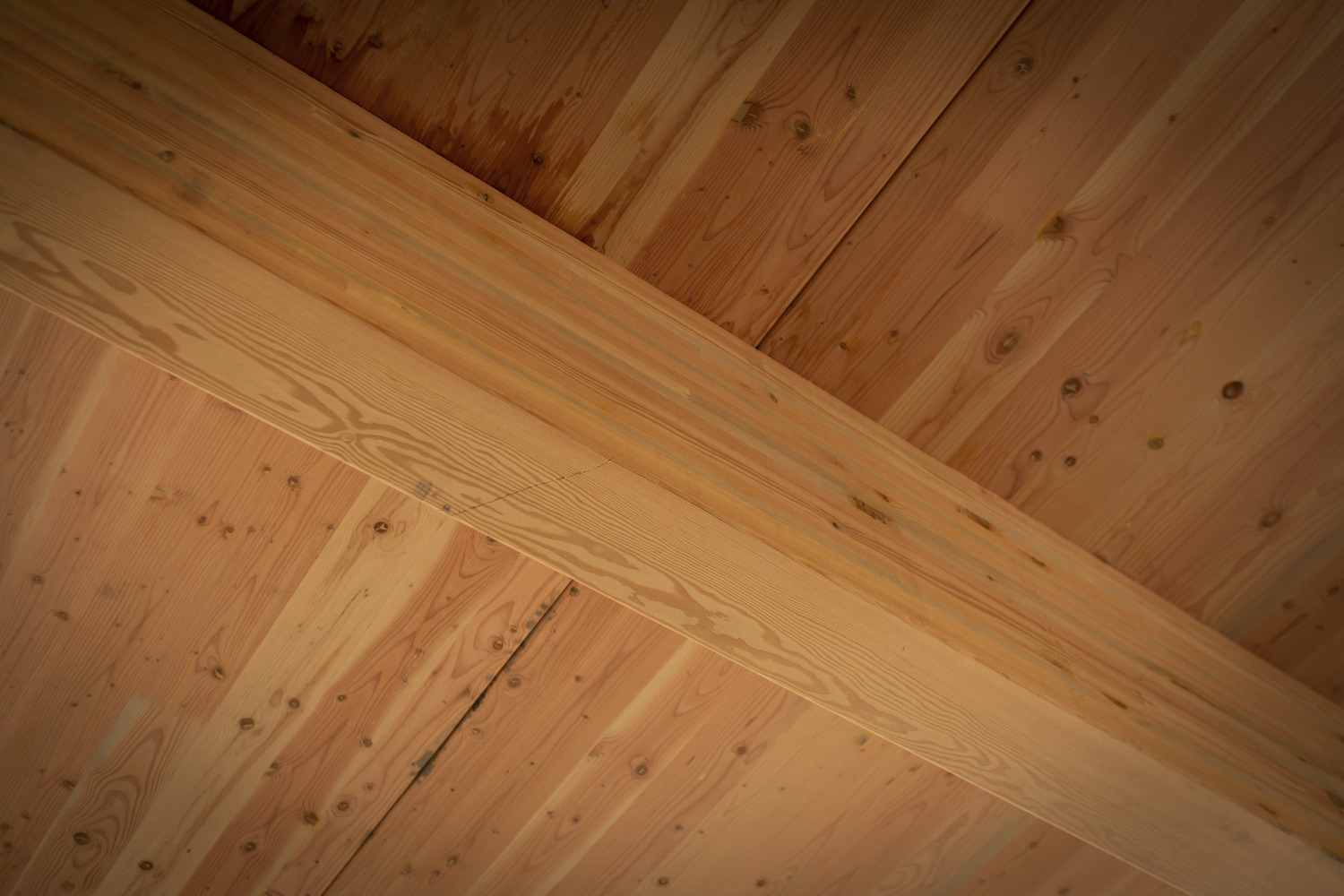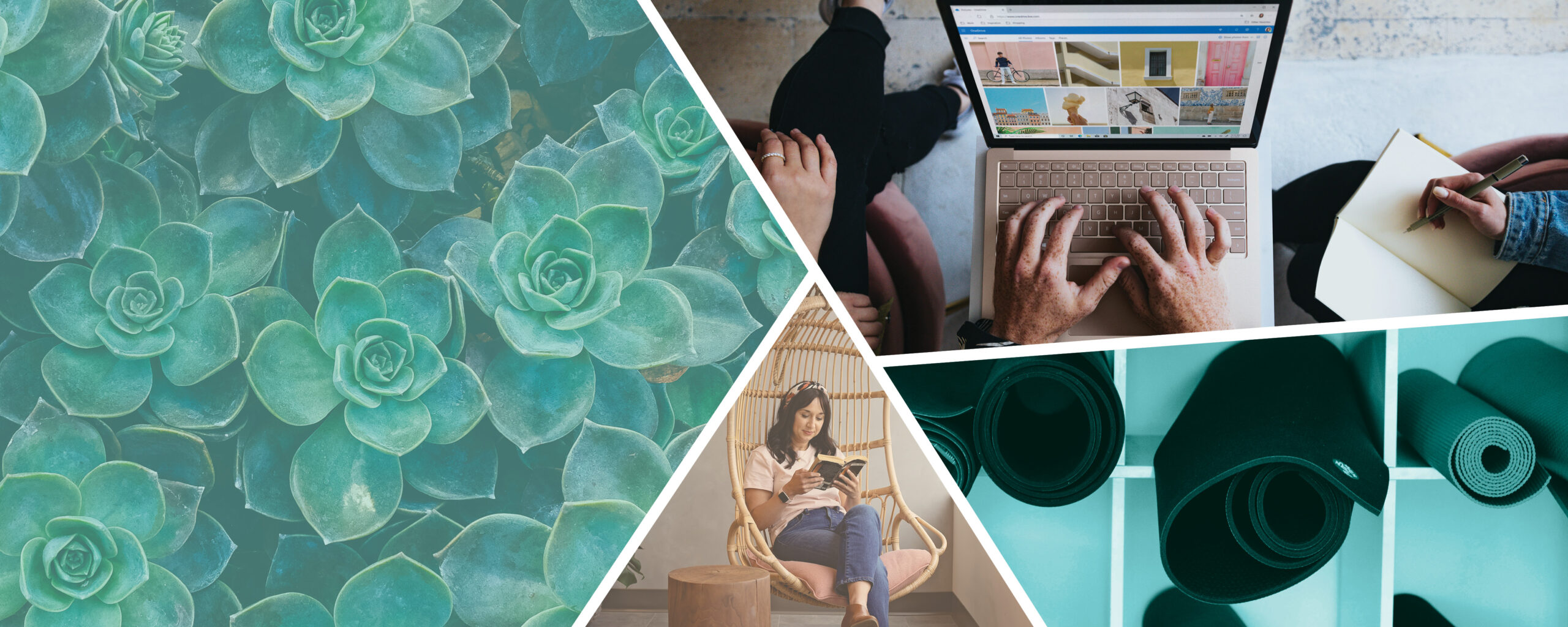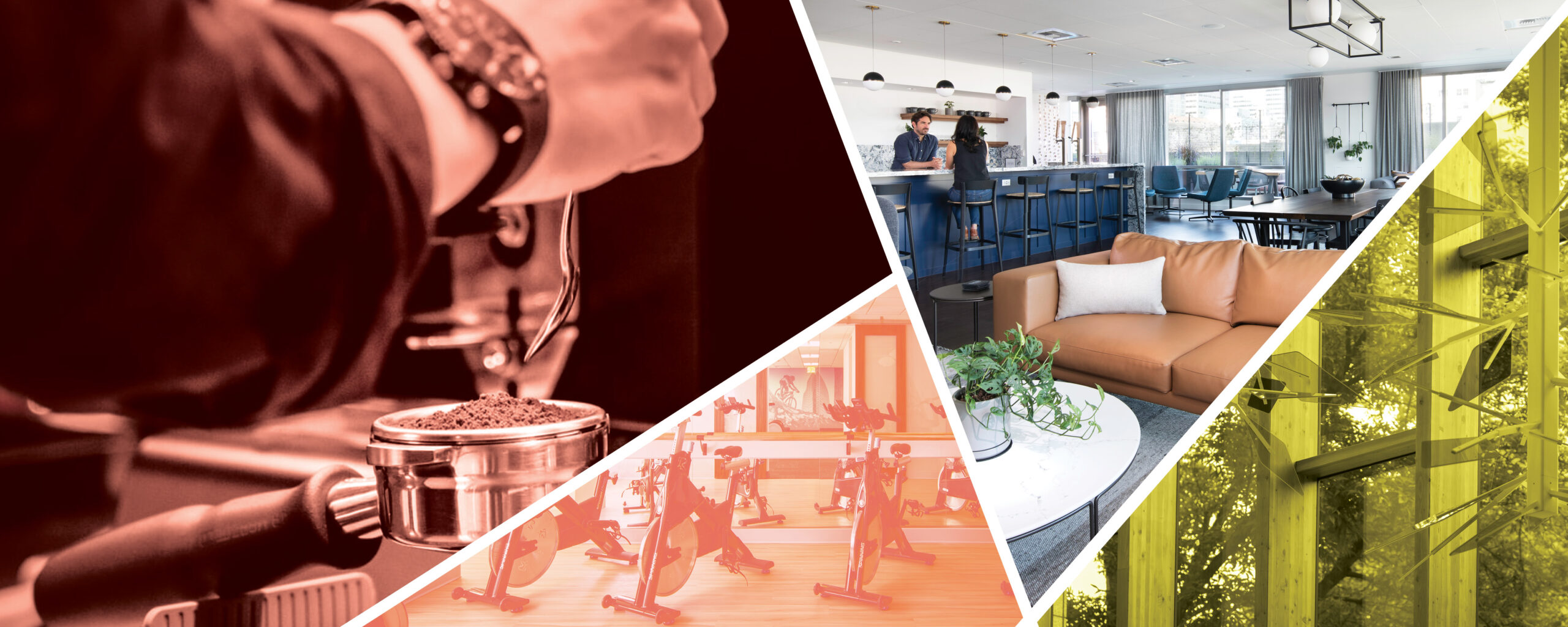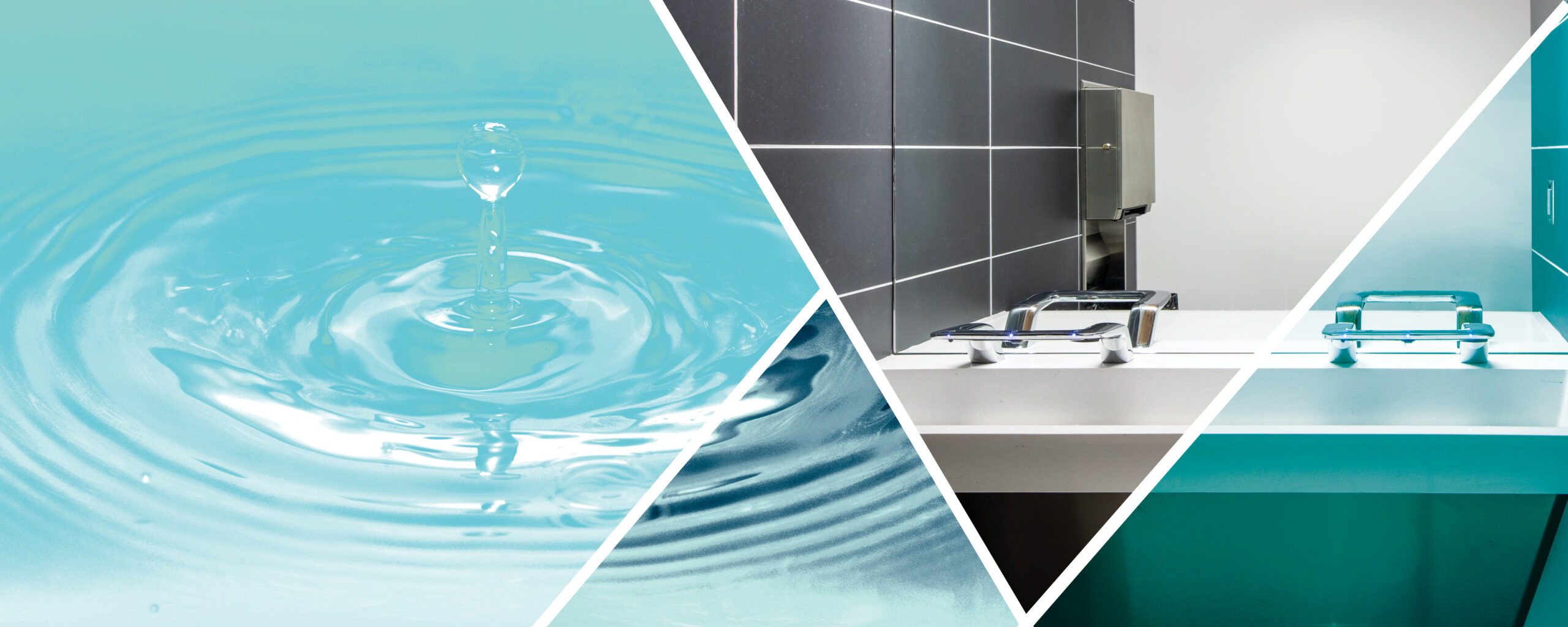Q: What efforts are Ankrom Moisan making to provide better information and resources when it comes to sustainability?
A: Ankrom Moisan was an early signatory to the AIA Materials Pledge, which encourages architects and designers to shift the way we evaluate the products and finishes we specify; taking into consideration the materials to improve the health of ourselves and our planet.
Erica curates and maintains a list of resources for our interior designers and architects to easily reference as they are evaluating and looking for the most appropriate product or material for their project. She also coordinates and organizes our vendor presentations and educational sessions; selecting topics around sustainability and healthy materials. The library prioritizes and highlights products to support human health, social equity, climate health, and a circular economy.”
Members of our sustainability reform group are also active members of the Portland Materials Transparency Collaborative (PMTC) and the Healthy Materials Collaborative (HMC). Both provide education, tools, and resources collected by our local A+D Communities. Additionally, this group works toward reformatting our specification template to make healthier and more sustainable choices the default. As part of that exercise, the team has created internal resources for prioritizing and selecting sustainable materials, such as resilient flooring.
Our firm sponsored eight interior designers to complete the Parsons Healthier Materials and Sustainable Buildings Certificate Program. This is a four-course program that allowed the designers to take a deep dive into sustainable material selections and bring enthusiasm and knowledge back to the firm, to their projects and clients. The designers who participated in this course were Jamie Kreger, Clare Goddard, Maddy Gorman, Ruth Bernal, Seaian Wood, Laura Serecin, Kaci Mespelt, Sydney Ellison. Ankrom hopes to have more interior designers complete this course in the future.
Q: Other firms have opted to remove all Redlist products from their library – Is this something that Ankrom Moisan is considering? Why or why not?
A: This is something that Ankrom is exploring as a firm-wide initiative, though we haven’t made the leap yet. The library is a resource to serve the designers and their projects. Steps in this direction that have been implemented were with PVC. We removed vinyl fabrics from the library and created a dedicated section for PVC-fee wallcovering. We also highlighted flooring products that are PVC free and/or provide full disclosure of material content to make it easier for our design staff to specify healthier flooring choices.

Q: How can we as designers do more to incorporate salvaged materials or encourage material reuse rather than replacing them with new ones?
A: Ankrom Moisan has relationships with a handful of salvaged wood brands in the region, as well as a salvaged metal fabricator.
As an interior design group, we collectively understand the importance of building relationships with local salvage companies to incorporate more reused materials into projects rather than buying new ones. We have an ongoing discussion to share experiences or ideas on how we can work with existing conditions and materials creatively to effectively reuse them in projects.
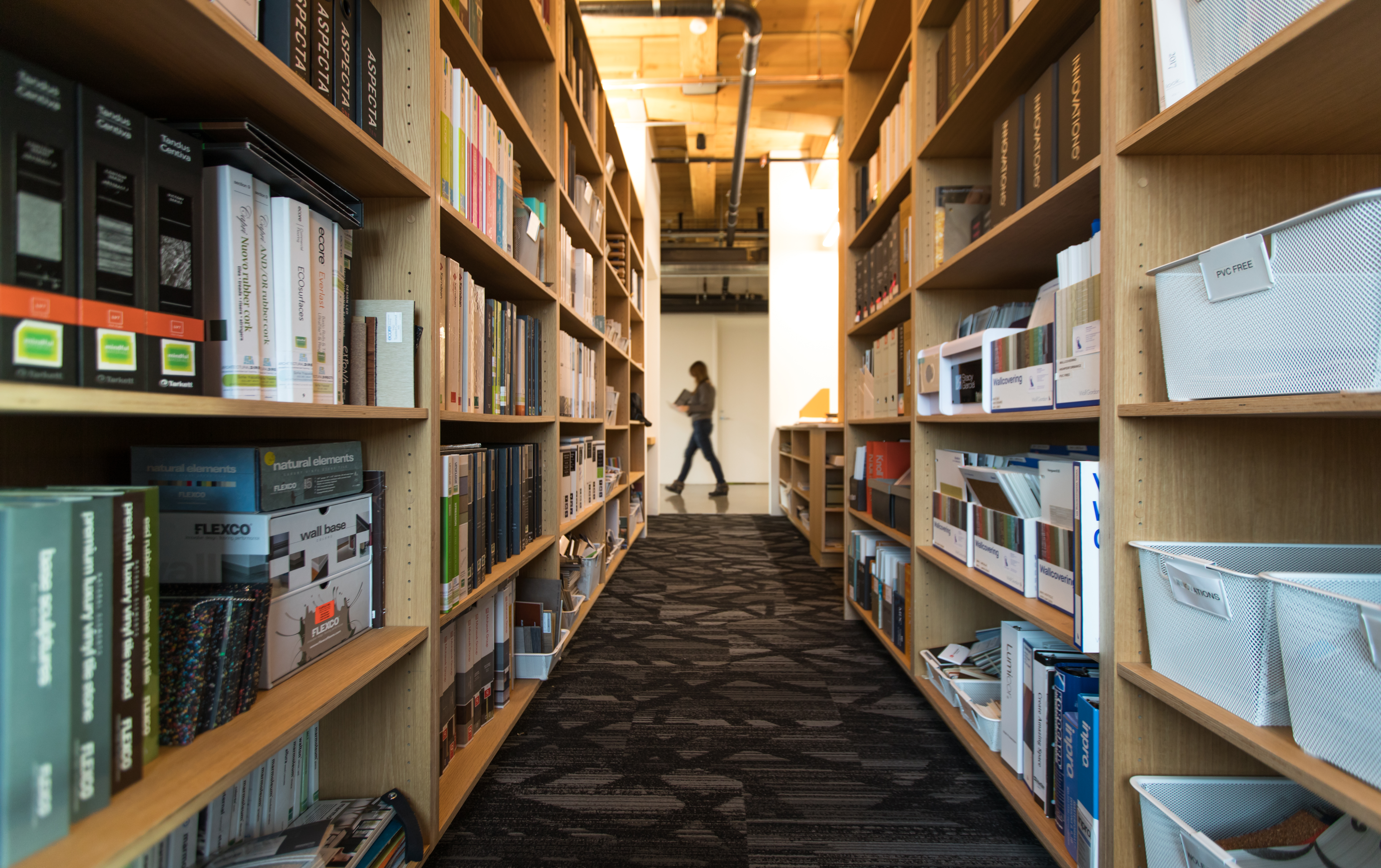
Q: What tools and resources are available to designers to help us educate our clients about the importance of using sustainable products and implementing sustainable practices?
A: Our greatest resource is the designer’s ability to strategically engage with the client and draw out what their values are around sustainability, equity, human health, and then being able to link those values back to your material selection strategy. Does the client have an Environmental, Social and corporate Governance (ESG) framework or vision that you can point to and say, “this is how healthier material selection can support your sustainability goals?” And then prioritize, together with the client, what aspects of sustainability you are going to focus on in your material selection, whether that’s human health, carbon emissions, social equity, DEI, etc. In the end, you work with the client to establish a goal around material selection and then use your material expertise and influence as a designer to execute on that goal. You also need the construction team on board, so they are on the same page when product substitutions are suggested.
Q: Where do you see the future of sustainability in Interior Design and Architecture? Do you see any changes on the horizon when it comes to how our industry approaches sustainability?
A: The conversation around climate change and sustainability is becoming more mainstream both within and outside the industry. Erica attributes this to the influence of Gen Z, who highly values sustainability, high-quality products that last longer, social equity, racial justice, and environmental responsibility. “They live these values in their consumer spending choices, where they chose to work, how they travel, etc. They have a positive influence on brands and manufacturers, pushing for change. They get it, they are listening, and the brands who want to remain relevant and stay in the game are trying to change and make products that match these values with processes and materials that are carbon positive, safe for humans, the environment, and society.”
We are seeing more and more businesses adopt Environmental, Social, and corporate Governance (ESG) mentioned in the previous question. This is a rating system developed by the United Nations that scores a company’s social and environmental factors. This is used to make informed choices around investments and future growth. As more and more companies adopt this the design industry will need to respond to help our clients make choices that align with their values and priorities.

Erica Buss, Senior Associate, Research & Information Services Manager
Designing for Inclusivity
Designing for inclusivity is something that is always on interior designers’ radar. ADA regulations instituted in 1990 blossomed into the concept of universal design: the creation of environments that, despite differences in age, size, and ability level, are safe for all users, can meet their needs, and support their health and well-being. However, the pandemic experience, the current political and social climate and the new need for virtual connectivity have challenged interior designers to push beyond implementing basic strategies to create inclusive environments.
What are some of the characteristics of inclusive environments? How can interior designers and their clients pivot to prioritize inclusivity?

Inclusive environments recognize that not all people experience space in the same manner. People want to feel supported and represented by the spaces they inhabit. The visual narratives that space creates for one person may trigger very different feelings within another. How do the colors, textures and light level affect one’s experience of a space? A conversational design process that discusses how elements within an environment land for the user helps to create relevant (and desired) environmental experiences.
Inclusive environments recognize that different people need different things in order to perform their best. And, that these things may change over the course of a day or may depend upon one’s mental state or the tasks at hand. Spaces that offer the user choices are key to managing these nuances. Some points to consider are: what posture might one want to have while in this space or performing their task(s)? Will they want activity to surround them or will they prefer more solitude? Do they want to see activity nearby or should visual distractions be minimized? What level of acoustic privacy is desired? These questions illustrate that not “one size fits all” and that inclusivity is prepared to provide options for users.
Inclusive environments enable everyone to participate equally, confidently and independently. People can move through and use the space intuitively – or, the information needed is provided and is easy to understand and implement. Wall graphics, signage, artwork, the integration of technology are considered. Also, not all accessibility concerns are centered around a permanent condition – our needs may change over the course of a lifetime or in different situations: we might experience limited mobility if using crutches, navigating a stroller or carrying bulky luggage. Empathy for the user helps interior designers consider as many variables as possible. This allows for intellectual and emotional access to a space and invites users to feel relevant and engaged.

Designing for inclusivity is important because it propels our culture forward. Inclusive environments and the experiences users have within them tell them their opinion and perspective matters. It allows them to be present and to bring their skills and knowledge into the conversation and hopefully, enriches everyone.

By Laura Serecin, Interior Designer
Mass Timber: 38 Davis
At 38 Davis, work and home is integrated through mass timber. Located in the heart of Portland’s Old Town Chinatown District, this building was the first ground-up construction to occur in the district in over a decade. One of the world’s first Leadership in Energy and Environmental Design (LEED) v4 certified developments, the building was designed with software guided fans and operable windows rather then relying solely on an HVAC supported air conditioning and heat recovery system. A testament to our commitment to sustainability, the 124,000 sq. ft. headquarters also features a greywater reclamation system and green roof that treats water and removes contaminants on site.
The six-story, mixed-use timber-framed building, which is home to our Portland headquarters, combines office, residential, and retail spaces. Expressing raw craft with care, the mass timber used in 38 Davis is more than warm and honest-it’s structurally sound and sustainable, lowering the building’s overall carbon footprint.
Utilizing a historic method of a traditional 3×4 tongue-in-groove floor panel system, the building features locally sourced Douglas fir timber beams and exposed columns, which can be seen from the inside as the beams come together in an energetic display of raw materials and craftsmanship that mirrors the work we do. This post-and-beam system allowed our team to create larger interior spaces, high ceilings, and large window openings, achieving our vision of a background “warehouse” space overlaid with a tech-forward workplace that is all parts beautiful and utilitarian, yet historic and comfortable.
As you enter the building, you flow through the ground floor communal thru lobby connecting entries along SW Davis and the semi-private mid-block courtyard with a custom backlit metal art was designed to represent the flow of the Willamette River as it moves through downtown Portland. In the lobby, reclaimed wood wraps the threshold to shared elevators guiding visitors from retail on the ground floor to office space on the second through fourth floors, and workforce housing on floors five and six.
We believe that diversity and sustainability are of paramount importance to the vitality of our lives, neighborhoods, and cities. Designing from an owner’s position, we seized the opportunity to create a vibrant, mixed-use development where we can live, work, and learn alongside local community members. The communal lobby, elevator, rooftop, bike storage, locker room and gym area create dynamic interactions between our staff, building residents, and University of Oregon students. A unique, inter-use greywater reclamation system filters runoff shower water from the upper residential floors and uses it to flush the toilet’s of the offices below, saving an estimated 202,800 gallons of water annually.
Employee Spotlight: Keith Larson
Did you know Ankrom Moisan has an in-house model maker?
Meet Keith Larson. While he’s been working as a professional modeler since the 1990s, his craft started as a kid playing with LEGO sets. To say he is detail-oriented is an understatement.
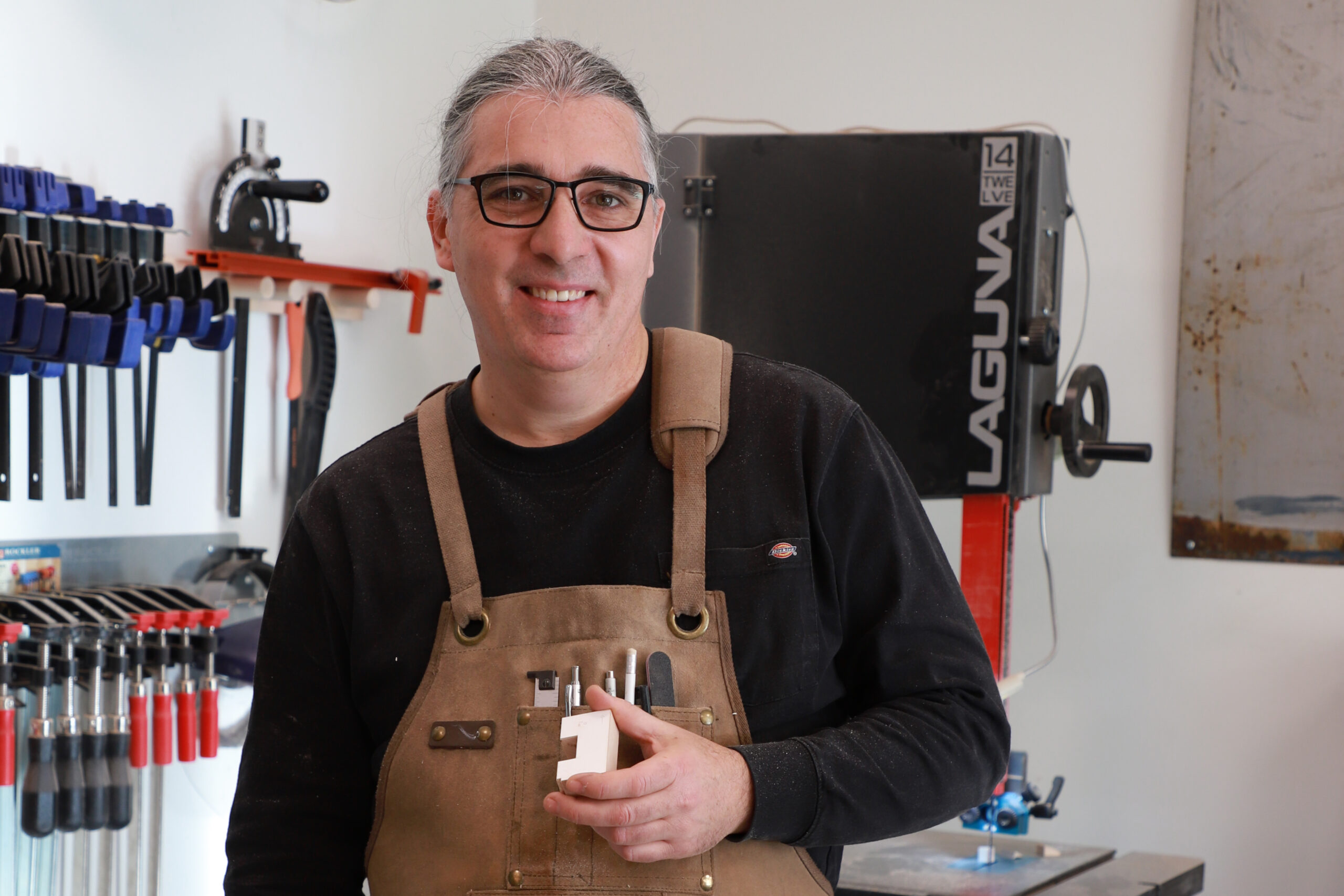
From making props on movie sets to creating 1/32” scale replicas of commercial airliners, Keith has an incredible portfolio from which he draws inspiration. Although his career has taken him through a broad spectrum of industries, his love for architecture and design has continued to bring him back to this world.
Since starting with Ankrom Moisan in 2016, Keith has collaborated with our project teams on models small and large, simple and complex. With such a diversity in markets and locations, every project brings something unique to the workbench.
When we asked our in-house model maker Keith Larson to share his current projects, Sandy Health Center was top of mind. The 1/16” scale finished type model includes scale people—a first for Keith’s work at the firm. Filled with details, the steep pitched roof was a particular challenge. Cutting the individual angles by hand and seamlessly assembling each piece was a personal triumph.
Keith worked very closely with the architecture team to ensure each detail was correct. The finished model represents a 9,500 sq. ft. facility that consolidates primary care, behavioral health, and dental services into one location. Following the Sandy Design Guidelines, the final architecture is a modern take on a rustic aesthetic.
🎬: Ankrom Moisan
Convenience Factor
The new standard is that services, products, and conveniences are available to people in a matter of minutes. Residents demand their communities to keep up with these changes and accommodate their needs seamlessly.
Download the Convenience Factor to explore how design can better address modern conveniences like food delivery and online shopping while also embracing the sharing economy.
Insights from the Advancing Mass Timber Construction Conference
Mass timber technology continues to develop rapidly as more and more projects seek to implement this beautiful, sustainable, and durable material. Our firm’s subject matter expert in this field, architecture senior associate Benjamin Stinson, attended the Advancing Mass Timber Construction Conference earlier this month. After participating in workshops, lectures, case studies, and more, Benjamin shared some of his key learnings and how they will influencer our projects.
Q: Why did you choose to attend this conference?
A: Mass Timber is an expanding construction technology solution in our industry and we need to stay ahead of the progress in both code and implementation strategies so we can best serve our clients that are interested in pursuing this great option. Mass Timber is also a construction strategy capable of providing the most substantive environmental impact that our industry has seen possibly ever. The use of Mass Timber at scale could take a huge bite out of the carbon debt we have built up and need to rectify in the coming years, so it is our responsibility to make it as easy a choice for our clients as possible by knowing as much as we can.
Q: Which conference session had the biggest impact on you?
A: Eric Corey Freed of CannonDesign gave an inspiring presentation about sustainability in design that moved me to want to do more to pursue sustainability with our clients, even when it may not be their first project priority. There is a social responsibility we face to make changes in our industry, and I think we need to do our best to make saying no to those changes in a project as difficult as we can.
I also saw a few great presentations about the Ascent Project, which is a 25 story residential project in Milwaukee, WI that includes 19 stories of mass timber. This project started before developments in the 2021 IBC new Type IV construction types that allow taller mass timber buildings and had to work through a lot of challenges to bring it to market. Even with those challenges, the developers were able to make it a beautiful, viable project. With our strong background in housing, there should be nothing stopping Ankrom Moisan from working with our clients to make mass timber housing projects a reality.
Q: What was something unexpected that you learned at the conference?
A: I had previously heard hints, but I learned that there is a proposal (G147) coming up for a vote that would open projects in the IV-B construction type up to 12 stories to allow 100% exposure in ceilings for the next code update. Exposure of the wood is often critical to bringing mass timber to projects, so opening this up for taller buildings will help our ability to present this as an option to clients. Fingers crossed that the vote goes through, and we can use this as a basis to get more exposed timber in our buildings.
Q: How will your learnings apply to your current projects (if at all)?
A: As Ankrom Moisan’s Mass Timber research lead, I am involved in mass timber discussions for multiple projects. What I learned at this conference will come to bear for a lot of our work currently considering mass timber for their schematic design. We are particularly focused on how this can become part of our broad scope of residential projects and how to bring more exposed timber to the living environment.
Q: So, what’s next for mass timber?
A: A key set of innovations that goes hand in hand with mass timber is prefabrication. Mass timber is systemically a prefabricated set of components and integrating prefabrication concepts into the construction process seems like a critical milestone in moving this construction strategy to scale. Constructing a building with prefabricated components can pose a significantly different process for contractors and partners, and streamlining is critical to making mass timber a viable solution. Change can be hard (and potentially expensive), but the more we know about the mass timber process, the more we can help our partners learn this great, new innovative structural solution and bring more buildings to market that make you feel as good being inside as you do being outside, standing among the trees.
Project Materials Spotlight
A trend our workplace team has been observing lately: landlords are considering their tenants more like customers and creating spaces as a lifestyle brand to attract and retain tenants in their buildings. In response to this trend, TMT Development contracted with our team to turn an irregularly shaped, difficult-to-lease suite on the 25th floor of the Fox Tower into a communal space where employees can meet, socialize or relax throughout the day/ after work.
We presented three design concepts to TMT, and they ultimately chose the “Staycation” scheme, which would bring a vibrant, fun environment to a generally overcast and earth-toned city view. Pulling inspiration from colors and textures from travels around the country and the world, I wanted the lounge to feel like you just stumbled into a lively, hidden gem of an outdoor bar in a historic area of town; a secret only the locals know about.
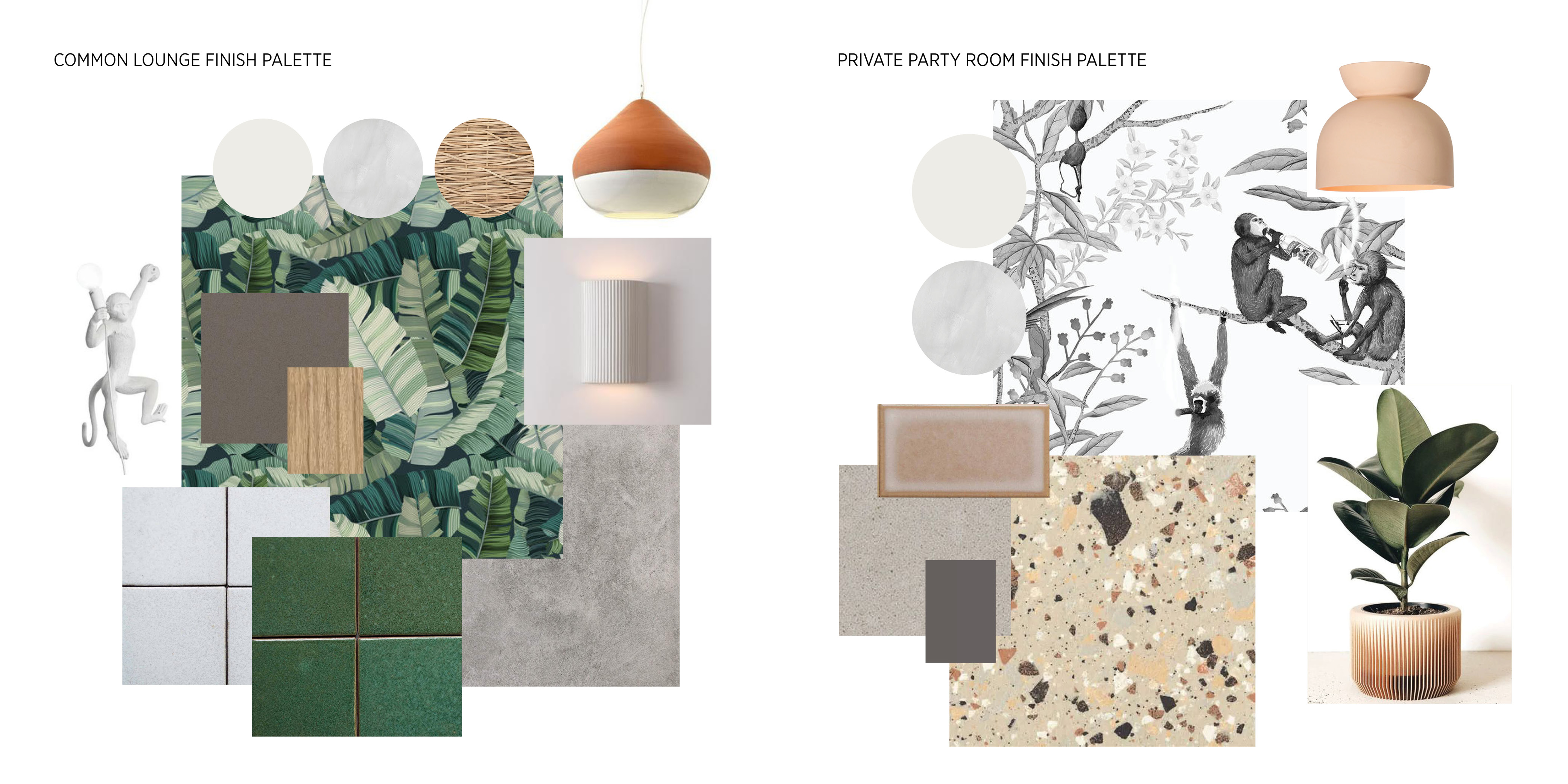
Materials are everything. They create mood, texture, ambiance, curiosity, and comfort. To achieve the “Staycation” look and feel, I specified Portola limewash paint to create a washed, rough texture on the walls, giving the effect of aged concrete walls. The terracotta light fixtures bring warmth through the natural clay material, while the sconces and surface mounted, handmade ceramic fixtures by local lighting company Cedar & Moss, add a touch of artistry and craft. In one of the early schematic mood boards, we included an image of a monkey light fixture; the client fell in love. We sourced the same fixture to add whimsy, humor and an element of discovery to the bar area. It hangs above the shuffleboard, camouflaged into the leafy wallpaper, a reward for those who pay close attention to their surroundings.
The mischievous monkey thread continues into the Private Party Room. From afar, the Astek wallpaper used in this room, meant for private gatherings and celebrations, looks sophisticated and simple. As you step closer, you realize your party is crashed by a bunch of wildly playful monkeys, again rewarding those who pay close attention to details! In contrast to the lush greens in the main lounge space, this room leans into warm tones with beautiful terrazzo floor tiles, and large bright planters.
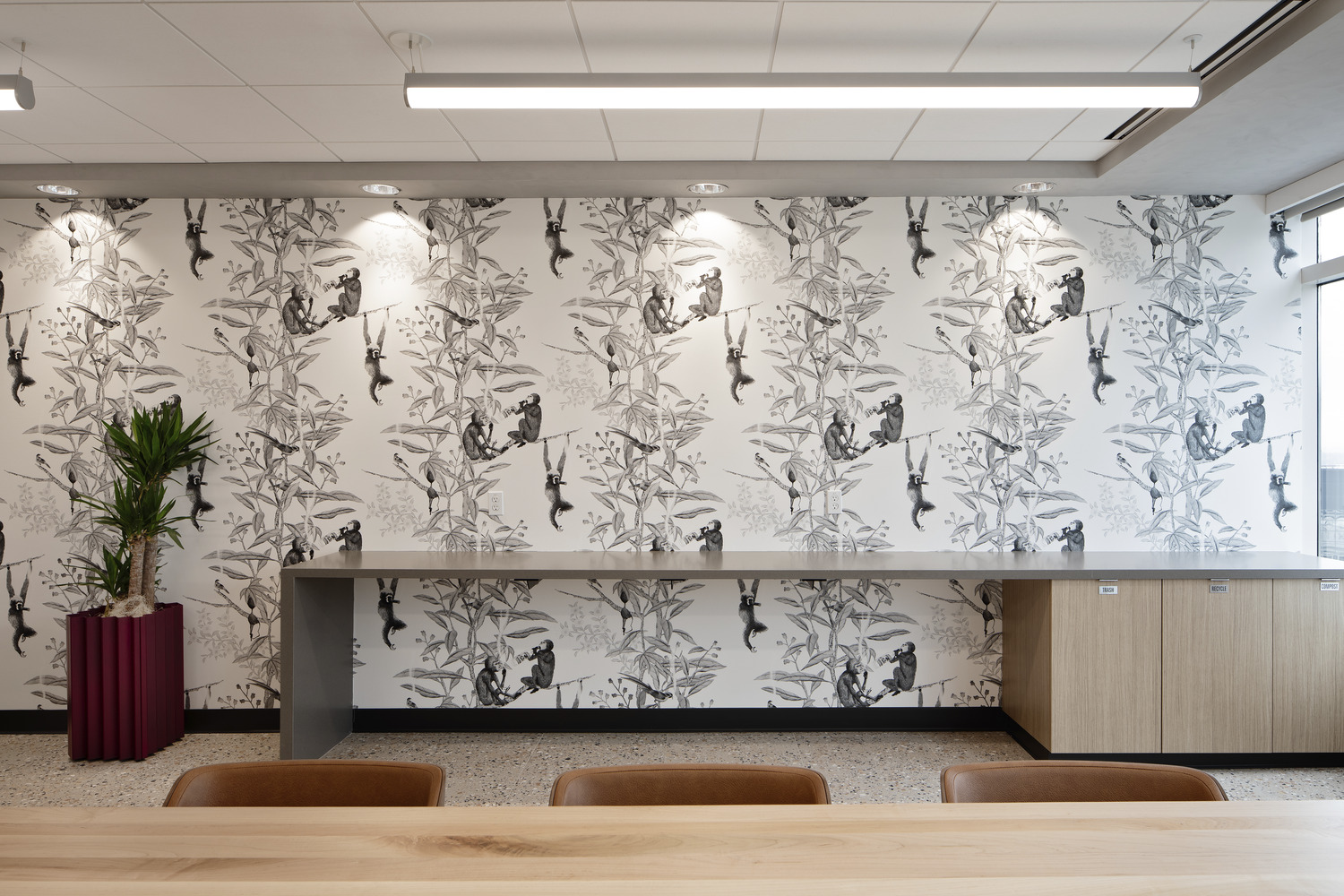
Located on the 25th floor, this suite has beautiful, vast views of downtown Portland and the forested hills beyond. The irregular shape of the suite lent itself to opportunities for a variety of seating types, including both social and more private areas. I knew I wanted the lounge to feel open yet “zoned” for different activities, so my original intent was to use modern breezeblocks to create a partially open partition to bring the natural light further into the main bar area and delineate between the main bar and the dining area. Because of cost constraints and limited installers that were willing to install the breezeblocks, we came up with an alternate, less expensive solution: a rope wall. Using simple brass rope attachments, manila rope, and an opening framed with walnut wood, this wall visually connects the two spaces and adds more textural material and character to the lounge.
The furniture and fixture selection was critical to the design concept: rope, leather, wood, and color were materials and elements I looked for. Bent-wood chairs hang from rope, swinging gently in front of the nearly full-height windows. Dark walnut chairs pleasantly contrast against white oak tables. Woven leather lounge chairs, solid wooden log side tables, and green powder-coated chair legs are placed throughout. And lastly, a bright yellow Smeg refrigerator in the main bar attracts your wandering eye, a piece of functional art. The result of these elements working together is a lounge that lifts your spirits as soon as you step foot inside. ✨
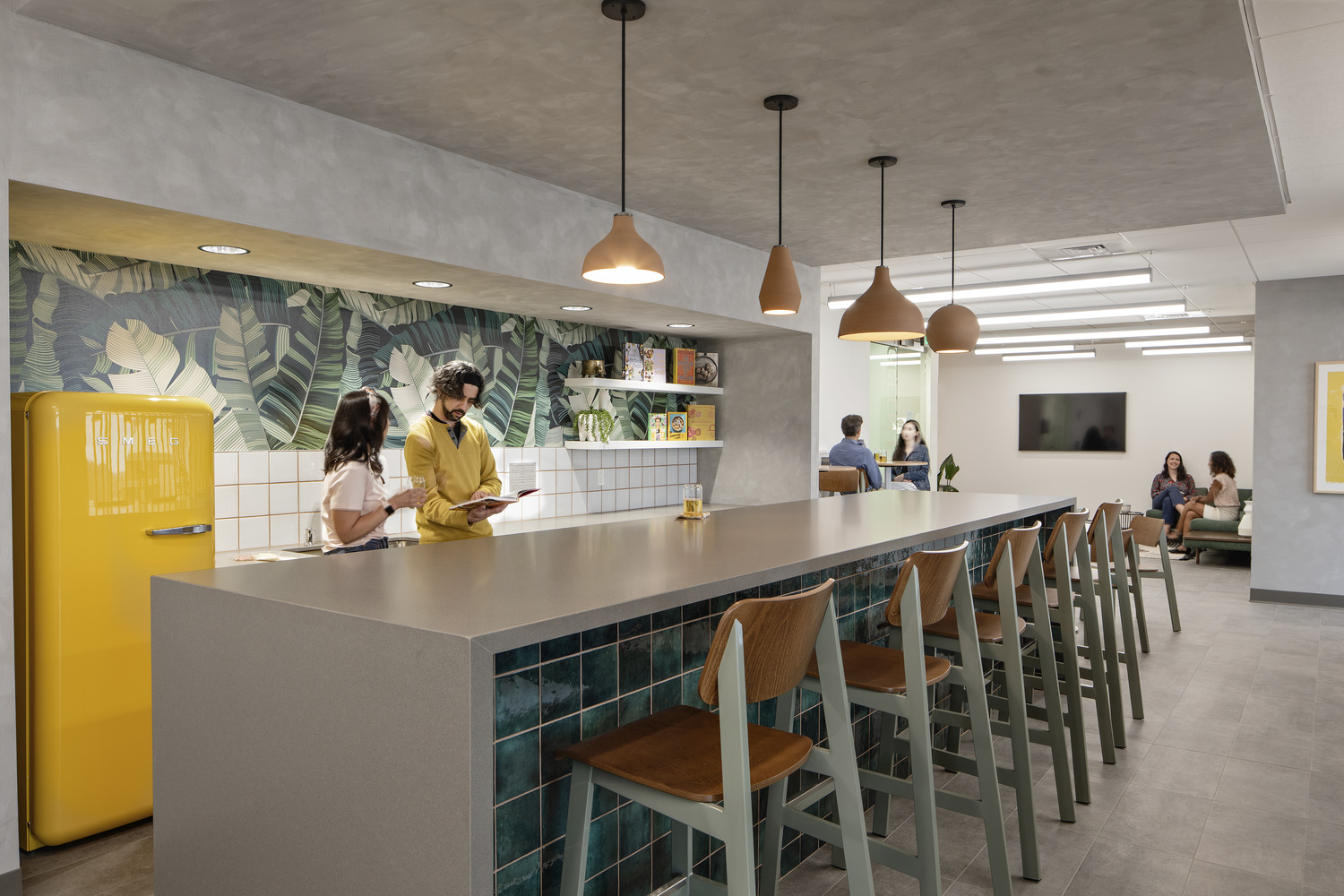

Maddy Gorman is a certified Interior Designer specializing in Workplace design, based in our Portland office since 2015. In her free time, she enjoys elements of discovery whether that is in nature, finding new delicious food combinations, uncovering patterns and stories through Tarot, exploring inward while lying still in a float tank, or traveling the world.
Office Design that Supports Employees Holistically
With more employers offering the ability to work from home—and most employees preferring to continue doing so, at least part time—a new challenge has arisen to develop workplace solutions for companies that are not able to offer remote options. Creating safe, welcoming, and enriching office environments are essential for businesses to foster a positive culture especially when their services necessitate in-person operations. How do designers and companies collaborate to address post-pandemic employee priorities and offer workplaces that are equitable, uplifting, and inviting to anyone who might want or need to be in the physical office space?
Human centered design strategies that focus on the employees’ perspectives and experiences are essential cornerstones to providing supportive solutions. We begin with conducting surveys or interviews to uncover a company’s unique work culture, concerns, and desires. These discoveries influence the entire design process and fundamentally shape our final solutions, rather than relying solely on our benchmarking and our expertise alone. For a recent client we discovered that if employees had to work in the office, they wanted spaces and tools to help them perform their job functions well and nurture themselves holistically.
With this insight as our guiding light, we developed four design prompts to help interior designers and business leaders evaluate and create space from the end-user’s perspective.
1. I am Valued:
Implement office features that help employees work effectively, thereby letting them know their efforts and commitment to being in the office is recognized and valued.
– Presentation stage with stadium seating open to everyone at any time.
– Integrated noise mitigation (acoustical wall panels, furniture screens, or ceiling baffles, as well as a white noise system)
– New, user-friendly technology (audio-visual equipment and high-speed wi-fi)
– Fully accessible floor plan
2. I am Well:
Recognize that health is currently a primary concern, especially for employees who must work in shared spaces. Provide designated areas where employees can decompress and designs that encourage movement in a safe and healthy manner.
– Wellness and Fitness Center (yoga or multipurpose exercise room)
– Connections to nature (outside views and plantings)
– Gaming area with active games like ping pong and foosball
– Advanced HVAC and lighting (increased fresh air and natural light, and enhanced controls so they can customize their work environment)
– Increased Bike Storage and shower amenities
– Daylit and cheerful break areas/kitchen/kitchenettes with specialty items such as espresso and fitness beverages.
– Multiple options of outdoor space with different orientations providing choices influenced by weather, activity, and time of day.
3. I am Learning:
Support employees in their lifelong education and growth by encouraging career development, learning, skill sharing, and team building opportunities.
– Focus rooms
– Library space for quiet studying
– Environmental graphics and design details related to the history and identity of the surrounding area
– Large gathering spaces for events and trainings
– Roof deck cooking classes
4. I am Caring:
Foster opportunities for employees to connect with their communities in the office and beyond to encourage a rewarding culture of caring.
– “The Great Hall” for local vendors to periodically sell their wares
– Community Leadership council room
– Outdoor entertaining area for neighborhood events
– Indoor entertaining area for movies and World Cup
– Local and natural materials to promote sustainability
With hybrid in office and work from home employment models becoming the norm, the stakes are higher for companies who are limited in their options for offering remote work. People want their employers to show them, through the very design of the physical office environment, that they are valued, their wellness matters, and they have opportunities to learn and offer care. Business success hinges upon creating a rewarding environment that reflects the principles important to employees and provides a conduit to enact positive change.
Lifestyle Experiences at Work
Natural light. Fresh air. Lush greenery. Hospitality-inspired amenities. Companies want to give employees a lifestyle package that makes people excited to come to work. To support their client’s heightened expectations, building owners and property managers must change their overall strategies and transition from seeing occupants as tenants to supporting them as customers.
Our designers collaborate with landlords to ensure their properties offer shared amenities—or, rather, services and experiences—that enhance the missions, lifestyles, and brands of their target clients. Human centered design, practiced with inclusivity and equity, is essential for creating common spaces, ensuring that they support diverse lifestyles and professional needs. We have developed three key guidelines for landlords to consider when creating a lifestyle-oriented workplace amenities strategy:
1. Identify the demographic and psychographics of the tenants they want to attract. Building amenities do not add value if they are not in touch with the professionals using the space.
2. Prioritize common spaces or amenities that the tenants share. Especially as many businesses are downsizing their physical office footprints, it is the combination of services and experiences available to all occupants outside of their suites that gives a building competitive edge.
3. Create spaces that address different lifestyle needs. Each business is unique. The landlord’s mission is to help enable both the individual and collective lifestyle goals of their tenants.
The challenge is that lifestyle expectations are ever evolving. We have seen repeatedly how office amenities transform from rare, exclusive offerings to eventually becoming table stakes. The current popularity of bicycle parking is a prime example. Curating unique, targeted amenity programs that make an impact immediately and long-term are key. Simple, underutilized spaces can be transformed to specialized lifestyle experiences that make a property stand out from competitors, by implementing unexpected, innovative amenities that are future forward.
Some strategies and tactics that we have recently designed for our landlord clients include:
– Repurposing underutilized or challenging-to-lease spaces;
– Creating Indoor/Outdoor connections – maximizing views, increasing connection points with the exterior, and, highlighting year-round meeting space on decks and patios;
– Relocating amenities to more visible locations;
– Reinventing bicycle parking and locker rooms to increase capacity and provide an elevated experience;
– Transition security stations transition to concierge desks;
– Expand Fitness and Wellness Centers to foster a holistic, healthy lifestyle message;
– Integrate innovative biophilia installations.
In a fluctuating, competitive market heightened by the pandemic, interior designers bring expert knowledge of places, people, and tactical concerns within commercial real estate. We support our clients in strategically elevating communal amenities, responding to tenant lifestyle needs now—and anticipate what is next.
Technology-Rich Workplaces
Before the pandemic, relaxing with coworkers in the office breakroom or preparing meals in the communal kitchen were typical, stress-free, even enjoyable aspects of the workday. Now, as employees are returning to offices after months of remote work and social distancing, sentiments around common spaces are more cautious and varying from person to person.
Practicing human centered design going forward means recognizing and respecting employees who have different levels of health concerns. Workplaces should give options for experiencing a space so even some of the most cautious individuals will feel safe.
While technology enabled businesses’ transition to remote work in 2020, now technology is helping us make the office feel more comfortable, clean, and caring. become more important components in our projects moving forward. Recently, we implemented several enhanced features into a client’s new corporate headquarters to reduce touchpoints and improve hygiene long-term.
Automatic doors reduce practically everyone’s points of contact from the moment they enter the building to their exit, along with increasing accessibility. Installing advanced HVAC systems improves fresh air flow. Our interiors and architecture worked with the client to ensure the special equipment was seamlessly integrated into their open, airy office design—high functionality without feeling intrusive or disruptive.
Touchless technology improves comfort and cleanliness in shared bathrooms. We used Bradley’s WashBar, an all-in-one automatic faucet/soap dispenser/hand dryer. It eliminates three potential touchpoints, reduces waste, and adds a sleek aesthetic element. We also installed traditional motion-sensor paper towels dispensers. Offering both methods maintains touchlessness while honoring employees preference for either option. After hours, a UV light will disinfect the bathroom as an added precaution for both employees and facilities staff. Touchless fixtures extend to their breakrooms, locker rooms, and wellness/mother’s room, creating a consistently cleaner, contact free user experience in communal areas.
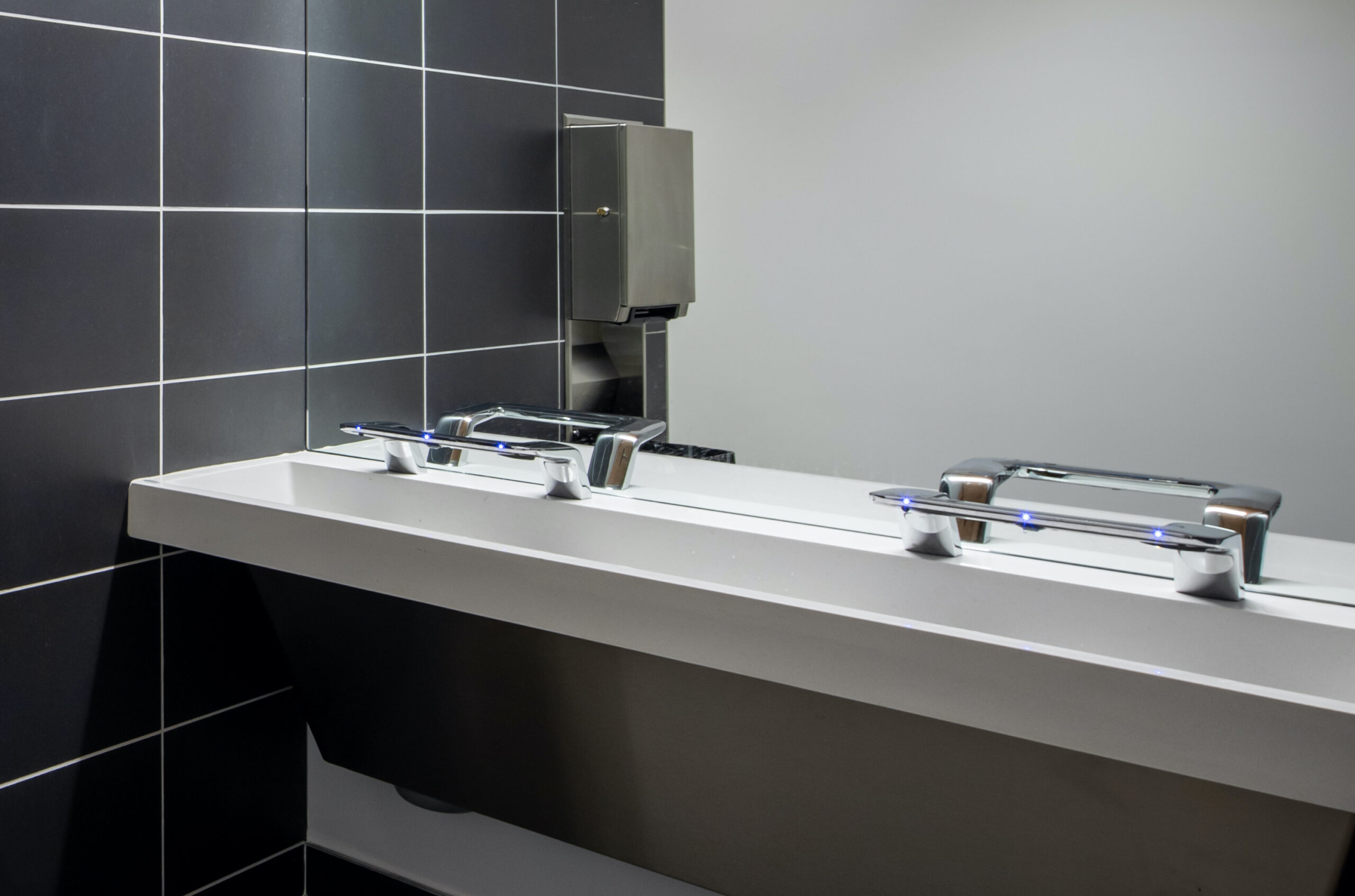
Solutions do not have to be high-end or technology-reliant—it can be as simple as how trash and recycling bins are stored. Instead of cabinets or drawers opened by hand, a touchless solution is hiding the receptacles under counters with holes that waste is simply dropped into. Of course, this method is far from new, but it is more applicable than ever for our minimal contact approach.
Touch means something different now to everyone. Through contact-free technology and thoughtful design details, we can find a solution that works for any workplace.








